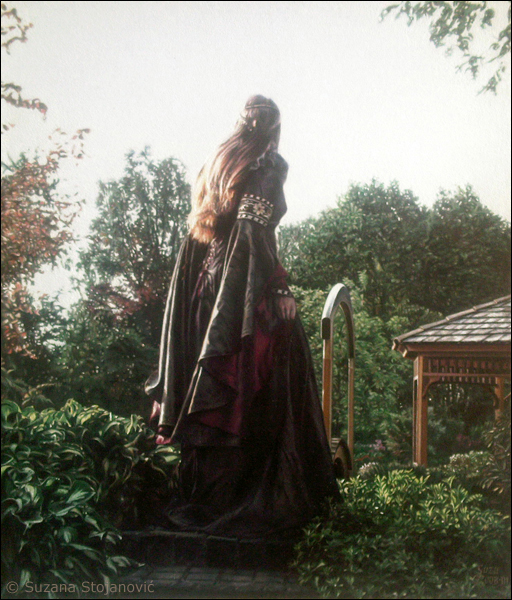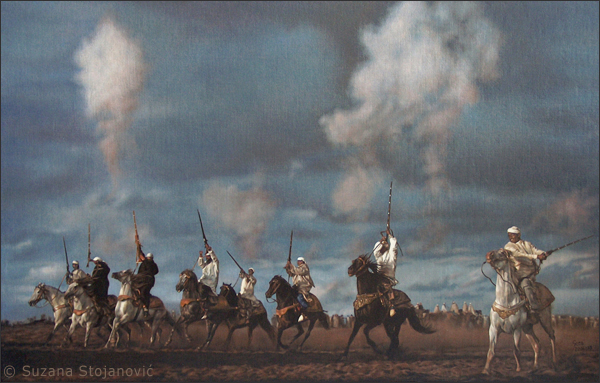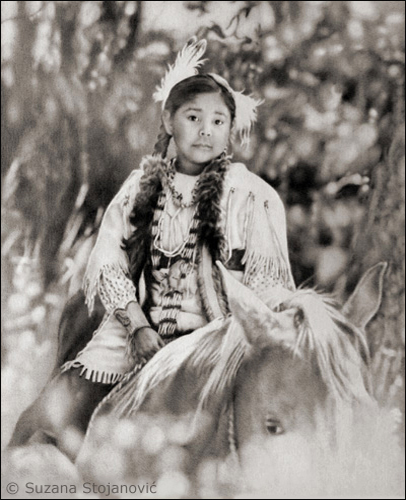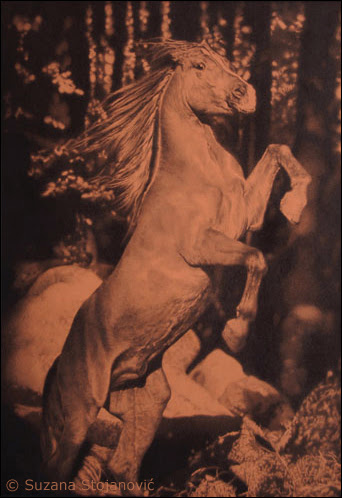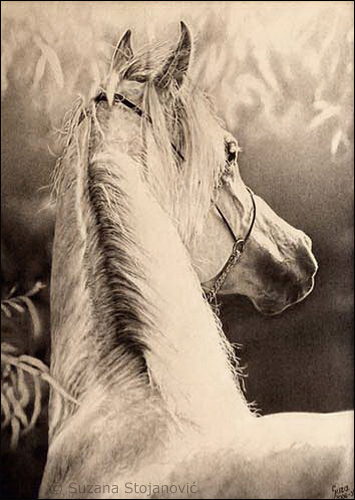“Morning” 2016.
30x39 cm
Detail
30x39 cm
Detail
50x40 cm
“Language of roses” 2003.
50x40 cm
“Awakening” 2002.
24x30 cm
“Whirlwind” 2002.
24x30 cm
“In front of the castle” 2002.
24x30 cm
۞
▪ Oil painting is a great challenge, eternal journey and quest. It has been changing for centuries within a very restrictive two-dimensional epoch, and it is still interesting. The blank canvas is the greatest challenge for every painter and does not leave him alone until it is finished, the challenge to head beyond the visible and the real, to look for the meaning of his spiritual adventure in a multitude of symbolic elements. Suzana Stojanović found the meaning of her artistic creation in the revival of everything that surrounds her. Her oil paintings on canvas include three motifs: portraits, animals and landscapes. She, often, combines all three elements into one whole (image “Friendship”), because, in her opinion, this “holy trinity” is the pillar of our civilization, its development and survival. The muted tones on this canvas show serenity, not so characteristic of the works of other creators with equestrian motifs. Suzana shows the moment of breather and relaxed positions of animal and the man who sits beside it. This oil is one of her most lyrical and harmonious works. The moment of sincere friendship, separated from untouched bliss, turns into eternity. Every detail is permeated with peace and poetry. As we look at this work, it’s almost impossible to get rid of the impression that there is an old photo in front of us. It is so precisely shown each element of the composition that we constantly wonder how the artist so realistically managed to show the subjects and the space to which they belong. Brown tones prevail in the image. Only the clothes of the man, which are characteristic for the territory of Hungary, are distinguished. This canvas is just one of the indicators that Suzana Stojanović in painting goes her own way. “There are parts of the painting that are done in one breath. Those are the moments when you squeeze the accumulated desire to create onto the canvas. Maybe you don’t remember all the procedures you applied in the work process, but you always remember those moments when you gave yourself completely”, says the author. The strength of her desire to create she embodied in the oil “Winner”. She thinks that races as a subject of working can not be fully perceived if the creator does not feel the feverish atmosphere and strong animals warmly desire for victory, when they are faster than the wind, when every vein on their body becomes an arrow that runs towards the goal. On this canvas, she manages to illustrate the flash of the equipment, to bring the animal to life and the flaming breath that blows from its nostrils. Each detail is confirmed by her remarkable gift of observation. The impression is that any movement, even the smallest trembling of the animal’s muscles, did not miss her sharp eye. The multilayered painting highlights the depth of the displayed space. Spilled contours of the pale green landscape in the distance increase the speed of the persistent animals. The dynamics of this composition point to one of the most important features of Suzana’s entire work - she can make masterful notes of a passing moment. One of her most representative oils is “The King”, in which, in the opinion of many experts, she has reached a level that is very difficult to overcome, not only because of the technique of oil colors, but also because of the light effects and many other details that this work are placed at the forefront of her creativity. However, under dignity, obvious superiority and a multitude of details, being without a glance and sad story is hidden. Aesthetic enjoyment at one point becomes a question: what is the life of this beautiful being and his friend from the blurred background that serves the king? How do those who have no choice to choose their own way feel? Do they always hide their views because someone convinced them that humility and obedience are the main factors of survival? A unique “The King”, besides that it attracts the views with a fluttering mane and interesting golden equipment with which it is tasseled, leaves many questions to the observers. The answers to these questions can be revealed in a limited, yet rich palette between gloss and darkness, grayness and whiteness. “Gray is the color of our defeat. The painters, who did not know how to illustrate all those nameless memories and moments in which they were not sure whether they were happy or suffering, whether they were falling or getting up, whether they were leaving or returning, created it. We accepted this color and it became an integral part of our day. It is that tall wall that always stands between us and our dreams, of which the living colors and hopes break. There is not enough big canvas in which we can place all those dreams, passers-by and words that we did not say. We are forced to paint in layers on this our, small. Its empty islands are desolate enough to describe all our remorse, foreboding, uncertainty and silence. Once, when space is no longer enough, we will also paint it with the last moves”, says Suzana in one of her stories. The change of palette is also visible on her oil painting “Bride”, which is characteristic of a very pronounced relief. Cold tones, which prevail in a bride’s environment, do not announce either joy or enthusiasm, but only a straight line interrupted by restless ruffles on a pale purple dress. This work uniquely illustrates transience. “The subject of painting can not be chosen, it chooses us”, says the author. The works in her gallery, viewed as a whole, are based on interweaving realistic and symbolic layers (image “Memories”). Although this canvas is dominated by a bright green hue, a lonely house in the distance, to which the man with a top hat faces, causes some other feelings. It seems that after many years he returned to his homeland and that the moments he once had left long ago in yellow fields flow through his thoughts. As we look at the beautiful landscape, it seems to us that we can feel the smell of spring. The “Message” is one of Suzana’s oils that also celebrate life and spring. A smiling woman, surrounded by flowers, leaves behind a landscape where clear and cloudy skies clash and she looks at certain, only her known person. The message carried by this look can be sensed from the position of the hand and the golden ring that shyly protrudes from the finger. This interesting portrait artist worked on a very smooth canvas, adapted to work with many demanding details and transitions from one texture to another and favorable for the effects achieved, but at the same time very difficult to paint in oil, because the brush glides on it like on a glass, and because of the non-covering colors, it is necessary to apply them in several layers. A lively pony on the canvas “Awakening” announces the beginning of some new searches and experiments. Despite modern trends in art and a growing number of creators who, because of faster and easier work, shift to acrylic colors, Suzana does not give up on the traditional, centuries-long easel painting, which begun now far away, year 1432. By virtue of the discovery of oil colors, the process, which enabled painters to conjure depth, light and gloss in the works and achieve the effect of glittering the eye and jewelry, was found. This process has created stable and unchanging sumptuous colors. By virtue of this technique, which has enriched many galleries with original achievements, easel painting became the music that accompanies us until today. Suzana Stojanović, an extraordinary animal oil painter and a tireless inventor of unusual faces, uses the oil medium with excellent refinement. Alternating thick and translucent layers, she manages to, on her own way, give her works beautiful tones and soft, glittering brightness. “The slow drying of oil colors allows corrections and different experiments which are very limited in other techniques”, she says. However, it often happens that, although stable, they are matting after several days of drying, and this can cause difficulties in working. She makes a medium for refreshing the matted parts of the painting of petroleum, varnish and linseed oil and she applies the colors with light touches of the brush in the form of a smooth, homogeneous and slightly thick mixture and works in several phases. First, on a tinted background, she does a detailed draft, and then depicts the most distant objects, and the closest and most important she always leaves for the end. She creates a mosaic of small colored surfaces with precise movements and thus she makes it possible for us to feel the pulses of life on the canvas. Her expression is constantly changing. Coloring occasionally becomes a pastel thanks to the shades of gray and blue. On her newer canvases and illustrations, she avoids the black color, which was characteristic of her early period of creation. Still, life’s tiredness, permeated with occasional disappointments and melancholy in ash shades, leaves a trace in every one of her oil paintings on canvas and in every unfathomable view that is lost in the distance. Tendency to realism in the portrait she revealed in her childhood, when she often worked portraits of persons around her, trying to discover in each one a specific characteristic line that would completely separate one from the group. “The face of the person is a great challenge because there is no harder work but with visual means to present the human soul. Portraying a man means to discover the truth about him, catch his thought and communicates with him. To send message to observers and figure out the enigma hidden in the human soul by the visual language and symbols is a challenge. Portraits require special study, clarification and analysis. Each of them is a palette of different feelings and expressions that are the result of deep inner states: surprises, tranquility, anticipation, defiance, unbelief, sadness, fear. The face is the landscape of man. In each of these landscapes, the historical movements of him and his ancestors are recognized, behind which there are different traces, told by his eyes. Portrait sometimes represents many personalities in one, revealing man’s psychology, naivety, life, loneliness and suffering, and sometimes infinitely happiness, welfare and hope in a better tomorrow”, she says. Her portraits from the early days show not just the ideal look of the model (some of these oils remained hidden today behind the wardrobes) as opposed to later works when in some cases those models are adapted to some aesthetic standards of contemporary society. The work “Challenge” in which rarely any hue missing is somewhere on the border between these two soils of experiments. It is characterized by freshness and the willingness of a young woman to cope with all the upcoming challenges. This canvas is just one of a series of confirmations that Suzana completely turns into natural light in her creativity, which may not be as attractive, effective and convincing as it is in the works of old masters (when the light, which comes from invisible and imaginary windows, illuminates only some parts of the face and body, and thus contributes to the mysticism and depth of the image), yet somehow emphasizes the vibrancy of the model and the openness of the space in which her models reside. “The challenge is to confront this environment in which a lot of details interweave and portray them all, without avoiding them, because they just contribute to the richness of works and experiences”, she says and introduces in her every work a unique element that differ it from all others. In the image “Challenge” there is many: starting from the emblem on the cap and vest of the woman to the colorful scarves that are wrapping her waist. Nevertheless, portraits on her canvases do not dazzle too much with external effects as much as the depth of character and individuality. It is very difficult to perform a detailed analysis of her characters, to get to know their thoughts and feelings and to imagine their life path, but that is exactly what gives their appearance an unusual depth that arouses curiosity. Portraits, both in her paintings and in literary works, reveal her power of psychological analysis. On them is reflected her personal stamp. Every creator has an angel who helps him work. It is sometimes an angel with wings that floats in the air, sometimes it is alive in some person, and sometimes it is completely invisible, we just observe it in the signs that it leaves behind. Suzana’s “Angel” is a collection of all this on one canvas. In gentle strokes of the paintbrush intertwined the whisper of past times, the beautiful face of the young woman, and the wavy hair of the color of wheat that separates from the vibrant background. The content of the image is very mysterious. Naples’ yellow, present in the background of the portrait, gives some special tone to this canvas. With this work, Suzana has shown that she really can depict women’s beauty and elegance and that she can be gracious, emotional and simple. The theme of her oils moves from portraits and trees to meadows, riders and water. Each of these motifs she presents different. “Oil colors carry some miraculous energy that can not be reached by any other technique”, says the author. Their power is evident in the work “Prayer” in the materialization of the knight’s armor, the volume of his body and the depth of space. The palette is vivid and clear, and it implies that the knight believes in the victory for which he prays. The fine lines of a young man’s face are contrasted with his impenetrable armor. Everything is painted exceptionally carefully, even decorations on the sword, which absorbs the brightness of the sky. In some parts of the canvas, especially the landscape in the background of a man, traces of the impasto technique, characteristic of Suzana’s earlier works, can be noticed. The arabesque of a knight’s silhouette and the atmosphere of the epic poem that surrounds this unusual work are etched in the memory. This oil is just one of the evidence that metamorphoses associated with the shift of time of day and the shift of the seasons leave a deep impression on the creator as well. Her opus is rich and encompasses the lives of many nations and different historical periods. “The artworks bear many traces of the culture in which they were created if the viewer carefully watches the portraits and objects that are displayed on them. Knowing when a work is done, the watcher can understand what life was like at the time when it was created”, she says and wants to return time on her canvases and illustrations. By coloring the lines, she writes a novel about the moments captured in the movements of a man and the lively animals that she depicts with convincing naturalism. Her sensual personality is most prominent in the way in which she shows the beings and landscapes surrounding them, embodying her by becoming the creator of a certain sophisticated style and a culture that is not superficial. It, which gives value and durability to her works, is their strength, coherence, uniqueness and magnificence of the subject. Whatever she is working, she always confirms herself: both in landscapes, in portraits, and even in still life (image “Language of roses”). Her oil paintings on canvas are evidence of the full commitment of her as an artist. She does not like improvisation and her technique requires time. By applying thin layers of colors, in order to get the necessary airiness in some parts of the painting, she has worked on her canvases for a long time, constantly improving her forms and experimenting with different pigments, creating an impression of unusual wealth, sophisticated and new, until then unknown hues. She chose this method to bring her visions and thoughts closer to viewers. “With the help of colors, the thought gets shape”, she says, for the reason she chooses oil colors for work because she thinks that she can express almost everything she wants: sadness and joy, coldness and warmth, love and suffering, existing and nonexistent. “Many walls of the galleries, decorated with magnificent works, are witnesses of important moments in human history, revolutions, upheavals, but also great loves. There are also some, perhaps intentionally unfinished works, whose truth is cruel and painful, and perhaps too beautiful to end. Brilliant canvases, created from the play of rebellious characters of painters and interesting models, colored the pages of the diary of many lives and minds. The beautiful redhead Fernande Olivier was left to rest on many of Picasso’s oils. Enchanted by the sophisticated and elegant Hermina Muni Dauber, Paja Jovanović transferred her beauty to many of his fascinating canvases. Even now, after many years, they rest side by side in the Alley of the Greats. Rubens reduced the portraits to two real women: Isabella and Helena. His life became closed to everyone else, and opens only to his beloved wives, whose faces became an indispensable part of many religious and mythological themes of the great master. Enchanting and gentle Emilie Flöge, Klimt captured in a strange composition of the painting, created a perfection that looks at us shyly after many years. Monet loved Camille-Léonie Doncieux so much that he painted her while she was lying on her deathbed. After the death of his beloved Gala, Dali remained living in the tower of the castle he bought for her, waiting for her to appear from somewhere and give him a hand, to rescue him from the darkness that engulfed him after her departure. They say that those who love too much lose everything. Maybe there is some truth in that. If in love we do not take what belong to us, someone else will. The desire to create is always waiting. It survived thanks to countless giving and taking”, writes Suzana Stojanović in one of her essays. She listens only to her own instinct and deals exclusively with what she is interested in, both in life and in art. She is in a continuous quest for tones, which are not always directed towards a realistic view and allows herself occasional exits from the frame of realism, and thus connects observers with her spiritual experiences. In her gallery of different styles and expressions there is a splendid panorama of interesting works, in which every canvas is woven out of the experience. From the inspiration and the move of paintbrush, the satisfaction of creation is born, full of surprises. Working with oil colors is complex, and, in many ways, mysterious human activity. Every human being sometimes feels the need to touch the unknown, to create something original. Painters are the only beings who can display their fantasies and experiences with tones that allow them to convey their sighting of the universe as it can not be expressed by other means. Suzana’s oil paintings on canvas (which can also be viewed in DeviantArt, Behance and ArtStation gallery) contain different ethical, sensual and symbolic elements, which often come from contact with reality. They are testimonies and documents about different cultures and customs that connect times and that we will be able to compare across them.




















